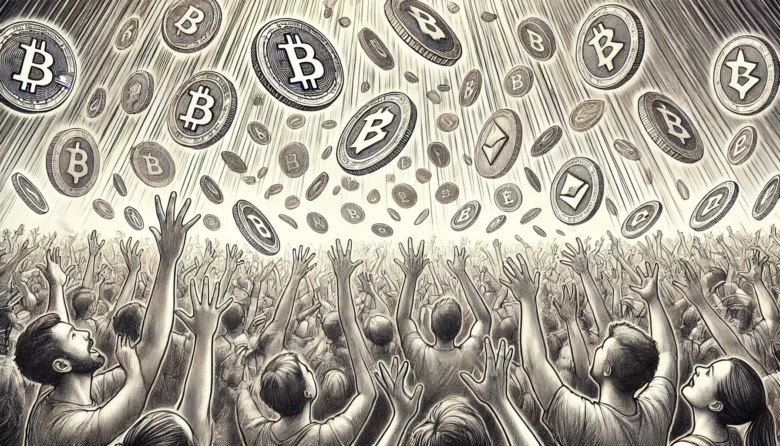The return of crypto airdrops: Opportunities and risks for 2024

Ed Prinz serves as chairman of DLT Austria, the most prestigious non-profit organization in Austria specializing in blockchain technology. In his guest articles, he focuses on the leading crypto assets and their role in the financial world.
Airdrops are a method in which cryptocurrency projects distribute tokens to users for free. This often serves as a marketing strategy to attract attention and create a broad user base. Airdrops can take various forms, including rewards for using certain platforms or services, participating in projects, or holding certain cryptocurrencies. This method is especially popular in the DeFi (decentralized finance) world, where it serves as an incentive system to ensure liquidity and encourage the use of protocols.
Airdrops play an essential role in the cryptocurrency ecosystem. They help to publicize new projects and build a committed community. The distribution of tokens promotes the acceptance and spread of the respective cryptocurrency. At the same time, airdrops offer users an opportunity to get to know new projects and benefit financially from them.
In this article, we explore the exciting world of airdrops, from the basics to specific projects like Layer Zero and Igen, to future opportunities and strategies to get the most out of these token rewards.
Layer Zero and the Zero Token Checker
Layer Zero is a major protocol in the decentralized finance (DeFi) space that aims to improve interoperability between different blockchains. It allows users to transfer digital assets seamlessly and securely between different blockchain networks. This ability is especially important in an increasingly fragmented crypto market where numerous blockchains exist that often cannot communicate directly with each other.
How the Zero Token Checker works
The Zero Token Checker is a tool designed to verify the eligibility of users to receive Zero tokens. This tool analyzes users’ activities on the Layer Zero protocol and evaluates whether and to what extent they are qualified for the airdrop.
Eligibility criteria
Eligibility for the Zero Token airdrop is based on various user activities and interactions with the Layer Zero protocol. Here are some of the key criteria:
1. Transaction fees (Layer Zero Core)
Users who have paid fees to bridge assets on Layer Zero qualify for token allocations. These allocations scale linearly with the amount of fees paid. This means the more fees a user has paid, the more tokens they can receive.
2. Specific interactions (RFP token allocations)
In addition to fees, users can also earn additional token allocations through specific actions such as providing liquidity, bridging certain assets (e.g. Ether), and using certain decentralized applications (dApps).
Example of token assignments
A practical example illustrates how the Zero Token Checker works: A user with a public wallet has received a total of 462.11 CFP (tokens). This allocation is based on the criteria mentioned above. The user provided liquidity, bridged specific assets, and used various dApps to obtain this amount of tokens. When the tokens are actually claimed on June 20, the amount allocated may even be larger than initially displayed.
User opinions and market reactions
User reactions to this airdrop were mixed. Some criticized that the rewards were a bit meager compared to the effort put into farming the tokens. Others, however, expressed satisfaction as they received a decent amount of tokens across multiple wallets. The pre-market trading prices of the Zero tokens suggest that this could be a lucrative airdrop despite the criticism.
Comparison with other airdrops
Interestingly, it was found that users who spent similar amounts farming on the Wormhole platform would have received a significantly larger amount of tokens, highlighting the different strategies and returns that can be achieved with different DeFi protocols.
Future token allocations
Layer Zero has held back a significant portion of token allocations for future seasons. This is to ensure that users continue to use the protocol and the bridge remains active. This strategy could help encourage sustainable use and participation in the Layer Zero protocol.
Phase Two of Igen Token Claims
Igen Layer is an innovative DeFi protocol that allows users to earn additional tokens by staking and restaking Ethereum (ETH) and leveraging complex DeFi protocols. After a successful first phase of token claims, the project is now in the second phase where more tokens will be distributed to qualified users.
Overview of Phase Two
The second phase of Igen Token claims will allow users who have performed certain activities on the platform before March 15 to claim additional tokens. This phase was introduced to reward users for their long-term participation and contribution to the platform.
Eligibility conditions
The exact conditions for participation in Phase Two are as follows:
1. Staking and restaking of ETH
Users who have staked or restacked ETH on the Igen platform will qualify for additional tokens. This includes staking via complex DeFi protocols like Pendle.
2. Deadline
The key date for calculating eligibility is March 15. All activities and points earned before this date will be taken into account.
Additional tokens
Users who meet the above conditions can view and claim their additional tokens on the Igen Layer claim page. An example shows that a user with an eligible wallet received an additional 6.5 Igen tokens. The estimated value of these tokens is around $10 in pre-market trading.
Meaning of the cut-off date
The March 15 deadline is an important aspect of this phase. Many users only started participating heavily in DeFi protocols after this date, especially after the success of the first phase of the Pendle campaign. This means that users who were active early on are now benefiting in phase two, while later participants may have to wait for the next phase to receive larger allocations.
Additional token allocations
Users who meet the eligibility requirements can view and claim the number of tokens they are entitled to on the Igen Layer claim page. An example illustrates this: a user who was active before March 15th, 2024, received an additional 6.5 Igen tokens with a qualifying wallet. In pre-market trading, the value of these tokens is estimated to be around $10.
Facts and Figures
- Deadline: 15 March, 2024
- Additional tokens: 6.5 Igen tokens per qualified wallet
- Pre-market value: approx. 10 USD per token
These additional tokens are a reward for users’ early and continued participation and ensure that users who were already active in the first phase remain motivated.
Continuous farming
Although the deadline for the second phase of token claims has already passed, farming remains active on the Igen platform. Users can continue to stake ETH and participate in complex DeFi protocols to earn points for the next phase. This suggests that users who continuously participate and continue their activities on the platform can expect greater rewards in future phases.
Assessment and perspectives
The second phase of Igen Token claims is viewed positively by many users as it represents recognition for early and continuous participation. The additional compensation of 6.5 Igen tokens per qualified wallet shows that the project is committed to rewarding its loyal users. With an estimated value of $10 per token, this provides an attractive incentive to continue to actively participate in the platform.
Future phases are expected to include larger allocations for users who became active after the March 15 cutoff date. This prospect motivates users to continue their activity on the platform and develop new strategies to maximize their chances of earning higher rewards.
Multiairdrops and the Ox Astra Airdrop
Multiairdrops are a strategy in the cryptocurrency space that allows users to earn different tokens by participating in multiple projects and platforms at the same time. This method is particularly attractive to DeFi enthusiasts because by spreading activity across different protocols and networks, they maximize their chances of receiving rewards. A prominent example of a multiairdrop is the Ox Astra Airdrop, which rewards users for their activity on different bridge platforms.
Multiairdrops: A multi-layered reward strategy
Multiairdrops involve a variety of projects and protocols that reward users for specific actions. Participating in multiairdrops often requires users to complete multiple steps across different platforms, such as bridging assets, providing liquidity, or using certain decentralized applications (dApps). These activities allow users to qualify for different airdrops simultaneously, significantly increasing their potential rewards.
The Ox Astra Airdrop: A Comprehensive Example
The Ox Astra airdrop is a great example of a multi-airdrop that rewards users for their activities on different bridge platforms. The airdrop involves multiple steps and platforms that users must go through to qualify for the rewards.
Eligibility conditions and platforms
To qualify for the Ox Astra Airdrop, users had to meet the following conditions:
1. Use of different bridges
Users who made transactions through specific bridge platforms such as Orbiter Finance and Ox Astra qualified for the airdrop.
2. Additional token allocations
Participating in multiple bridges allowed users to earn various tokens such as the Orb Guy token.
An example illustrates this: a user who actively participated in these bridges was able to exchange his Orb Guy tokens for about 0.1 ETH. This covered a large part of the transaction costs incurred by farming on these bridges.
facts and figures
- Token Received: Orb Guy Token
- Value of the token: about 0.1 ETH
- Use of bridges: Orbiter Finance, Ox Astra and others
Further airdrop opportunities within the Ox Astra Airdrop
The Ox Astra Airdrop also includes participation in other platforms and projects that offer additional rewards. These include, but are not limited to, the following networks and tokens:
1. Park Line
An upcoming airdrop where users can earn points for providing liquidity and other activities.
2. Tao und Arbitrum
By bridging assets on platforms like Arbitrum and Tao, users can earn additional rewards.
3. Optimism und ZK Sync
These networks also offer airdrops for users who perform specific actions on the platforms.
Strategies to maximize rewards
To maximize rewards from multiairdrops, users should leverage multiple platforms and networks. This requires thorough planning and following announcements and updates from the crypto community. Here are some proven strategies:
1. Diversification of activities
By spreading activity across multiple platforms, users increase their chances of earning different tokens.
2. Bridging assets
Bridging assets on different networks is an effective way to qualify for multiple airdrops.
3. Use of DeFi protocols
Participating in DeFi protocols like Pendle or the Igen Layer can earn additional points and rewards.
Future Airdrop Opportunities
The world of airdrops is constantly evolving, with numerous projects regularly announcing new reward campaigns. These campaigns offer users the opportunity to earn valuable tokens through specific activities and interactions with various platforms and protocols. Here are some of the most promising future airdrop opportunities that crypto enthusiasts should keep an eye on.
One of the most exciting future airdrop opportunities is Linea Park LXP . This project has already caught the attention of the crypto community and plans to distribute tokens in multiple phases. The airdrop will begin on June 20th and will run for six months, or until a total of $3 billion in Total Value Locked (TVL) is reached. The airdrop is divided into multiple Volts (phases), with each phase offering different amounts of points for activities such as providing liquidity. With each new phase, the number of points awarded for activities decreases, so Volt 1 was the phase with the highest rewards.
Mitosis is another project that stands out for its innovative airdrop structure. The project recently opened the fourth epoch, which for the first time has no cap on deposits. Users can now deposit unlimitedly on the supported networks, with Linea and Mode being two of the preferred networks. The next major airdrop is expected on June 26th. This development offers users the opportunity to earn additional rewards through continuous deposits and activity on the platform.
The Tao mainnet offers weekly challenges where users can earn additional rewards by completing specific actions such as bridging assets. In the current week 2 challenge, users must complete at least one bridge transaction to qualify for the rewards. Users will earn points and badges for completing the weekly tasks, with the more transactions a user completes, the more points they can earn. These weekly challenges provide a regular opportunity to earn additional rewards through continuous participation.
Zeta Markets , a perpetual derivatives platform on Solana, is planning an airdrop for June 20th. It is expected to either release the eligibility checker or distribute the actual token. Users who have been actively trading on the platform are expected to be rewarded. This announcement has already piqued the interest of many crypto enthusiasts who are looking forward to the upcoming rewards.
The Jupiter Exchange on Solana has proposed an interesting airdrop mechanic that rewards users for staking JUP tokens. A proposal to burn 30% of the total supply resulted in an immediate 10% price increase. Users who stake their tokens for 30 days can expect additional rewards and airdrops. These measures are designed to encourage long-term user participation and interest in the platform.
Ironclad Finance offers a complex airdrop structure where only the top 888 users on the leaderboard are rewarded. Users receive an OIC token that grants the right to purchase the actual ICL token at a set price. Holders of the OIC token can earn a share of the platform fees over time. The tokens are distributed in three phases: 50% immediately, 25% after one month, and the remaining 25% after two months. This structure ensures that only the most active and engaged users are rewarded.
Renzo is a leading project in the liquid restaking token space and has recently announced some significant developments. The project has received $17 million in funding, which increases confidence in the project. Users can now withdraw their staked tokens, which should help restore the 1:1 peg between ETH and EZ-ETH. Due to the three-day withdrawal period, arbitrage opportunities are expected to emerge, further stabilizing the peg. These developments are a positive sign for the future of the project and its users.
The second season of the Airdrop mode offers new ways for users to earn points and improve their position on the leaderboard. Compared to the first season, the points for activity on the network have been significantly increased. 5 million points will be distributed daily based on transaction volume. The new point allocation system also gives users with smaller assets the opportunity to compete against larger players and earn attractive rewards.
In summary, these future airdrop opportunities provide a variety of ways in which users can be rewarded through their participation in various projects and platforms in the DeFi sector. By strategically planning and diversifying their activities, users can maximize their potential rewards and benefit from the numerous airdrop opportunities offered by the DeFi sector.
Challenges and strategies for airdrop farming
Airdrop farming is a popular method among crypto enthusiasts to obtain free tokens from various projects. However, it is a challenging and time-consuming activity that requires careful planning and strategizing. This chapter explains in detail the main challenges of airdrop farming as well as proven strategies to maximize rewards.
Challenges of Airdrop Farming
One of the biggest challenges of airdrop farming is the complexity and variety of requirements imposed by different projects. Each project has its own criteria for participation and qualification. These may include holding certain tokens, using special DeFi protocols, or conducting transactions on certain platforms. Here are some specific challenges:
1. Diversity of requirements
Each airdrop project has different requirements, making it difficult to keep track and ensure that all criteria are met.
2. Time required
Airdrop farming requires a significant amount of time to utilize the various platforms, meet the requirements, and claim the tokens.
3. Transaction costs
Every interaction with a blockchain incurs transaction fees that can quickly add up. These costs must be weighed against the potential rewards.
4. Fraud risks
In the crypto world, there is always the risk of scams and dubious projects. Users need to be careful and make sure they only participate in trustworthy airdrop campaigns.
Strategies to maximize rewards
Despite these challenges, there are proven strategies that users can employ to maximize their chances of receiving valuable airdrops. These strategies include diversifying activities, targeting specific platforms, and managing resources efficiently.
Diversification of activities
One of the most effective strategies for airdrop farming is to diversify activities. Instead of focusing on a single project, users should participate in multiple airdrop campaigns at once. This increases the probability of receiving different tokens and maximizes overall returns. For example, users can participate in campaigns such as Linea Park LXP, Mitosis, and Tao Mainnet at the same time.
Targeted use of certain platforms
Another important approach is to target platforms that offer regular airdrops. Platforms like Pendle, Igen Layer, and various bridge protocols like Orbiter Finance and Ox Astra are known for their regular airdrop campaigns. By actively using these platforms and meeting their specific requirements, users can significantly improve their chances of receiving airdrops.
Efficient management of resources
Efficiently managing available resources is crucial to airdrop farming success. This includes both financial and time planning. Users should carefully monitor transaction costs and ensure they do not spend more on fees than they can potentially receive in airdrop rewards. It is also important to use available time efficiently and develop a clear strategy on which activities to prioritize.
Practical example: Optimizing participation in airdrop campaigns
A practical example to illustrate these strategies is participation in the second season of the Airdrop mode. In this season, points for activity on the network have been significantly increased. Users can earn 5 million points daily based on transaction volume. By conducting targeted transactions on the supported platforms, even users with smaller assets can compete against larger players and receive attractive rewards. This strategy requires careful planning and targeted use of available resources to get the maximum number of points and increase the chances of receiving higher airdrop rewards.
News and developments in the airdrop landscape
The airdrop landscape is constantly evolving, continuously producing new projects and innovations that pique the interest of crypto enthusiasts. This chapter highlights the latest developments and trends in the airdrop world, with a special focus on current projects, strategic changes, and the impact on the community.
Current Airdrop Projects
One of the most recent and promising projects in the airdrop landscape is Zeta Markets, a perpetual derivatives platform on Solana. On June 20, Zeta Markets is expected to release either the eligibility checker for their token airdrop or the actual token itself. This announcement has already generated a significant amount of attention within the crypto community. The users who have been actively trading on the platform are expected to be rewarded, which could further boost trading on Zeta Markets.
Another interesting project is Jupiter Exchange, also on Solana, which is making waves thanks to its innovative tokenomics strategy. A proposal to burn 30% of the total JUP token supply resulted in an immediate 10% price increase. This strategic maneuver aims to increase the value of the remaining tokens while making the rewards for staking JUP tokens more attractive. Users who stake their tokens for 30 days can expect additional rewards and airdrops. These moves are designed to increase long-term participation and trust in the platform.
Strategic changes and innovations
Ironclad Finance recently introduced a complex airdrop structure based on a leaderboard system. Only the top 888 users on the leaderboard are rewarded, creating intense competition among participants. Distribution is done via an OIC token, which gives holders the right to purchase the actual ICL token at a set price. Holders of the OIC token can also earn a share of the platform fees. The tokens are distributed in three phases: 50% immediately, 25% after one month, and the remaining 25% after two months. This structure is designed to ensure that only the most active and engaged users are rewarded.
Renzo , a leading project in the liquid restaking token space, has also made significant progress. The project recently received $17 million in funding, which boosts confidence in future development. It also introduced the ability to withdraw staked tokens, which should help restore the 1:1 peg between ETH and EZ-ETH. This innovation could open up arbitrage opportunities that will further stabilize the peg. Due to the three-day withdrawal period, this stabilization is expected to gradually take hold.
Impact on the community
The second season of the Airdrop mode also brings innovations that are particularly interesting for users with smaller assets. Compared to the first season, the points for activity on the network have been significantly increased. 5 million points will be distributed daily based on transaction volume. This change also allows smaller users to compete against larger players and earn attractive rewards. This promotes diversity and participation within the community and motivates more users to actively participate in the platform.
Another notable project is the Mystiko Network, which released its xzk Airdrop Checker, which allows users to see the number of points they have earned based on their past activity. This transparency helps users adjust their strategies and target future airdrop campaigns to maximize their chances of earning rewards.
Conclusion
The Zero Token Checker and its associated Layer Zero airdrop represent a significant development in the DeFi space, incentivizing users to actively participate in the platform and rewarding them for their interactions. Despite some criticisms, preliminary results show that the airdrop can be potentially lucrative. Continued participation and use of the protocol could lead to further rewards in the future, making Layer Zero an attractive option for DeFi enthusiasts.
Phase Two of Igen Token Claims marks a major milestone for the project and its users. By taking into account activities before March 15, early participants will be rewarded while continuing to encourage continuous farming for future phases. The additional token allocations provide an attractive financial incentive and contribute to long-term user participation. This not only strengthens the user base but also the stability and growth of the Igen platform in the DeFi ecosystem.
Multiairdrops provide a comprehensive way to earn rewards by participating in different cryptocurrency projects and platforms. The Ox Astra airdrop is an exemplary example that shows how users can collect different tokens by leveraging different bridging platforms and networks. By strategically planning and diversifying their activities, users can maximize their potential rewards and benefit from the numerous airdrop opportunities offered by the DeFi sector.
Disclaimer: This is my personal opinion and not financial advice. For this reason, I cannot guarantee the accuracy of the information in this article. If you are unsure, you should contact a qualified advisor you trust. No guarantees or promises of profits are made in this article. All statements in this and other articles reflect my personal opinion.





























